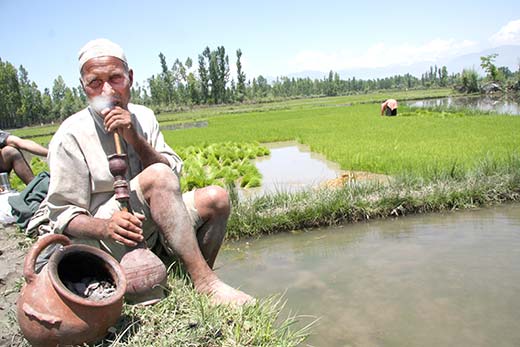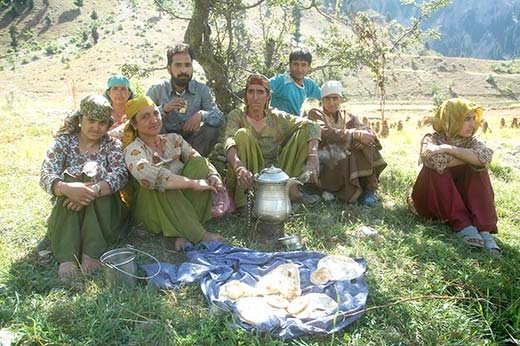Two latest medical pieces of research have held the prevalence of smoking and salted tea as the main factors for the increased prevalence of deadly cancer in Kashmir. On the basis of the records of the last two decades, doctors foresee the crisis doubling its victims by 2027, reports Saima Bhat
By 2027, the cancer cases in Kashmir would be doubling its prevailing numbers, medical researchers say. Two latest studies by SKIMS doctors involving a substantial number of cases suggest the most common cancer types are oesophageal and gastro-oesophageal (GE) followed by cancer of lungs in males and breasts in females.
Among the 24768 patients with malignancy reported to Regional Cancer Centre (SKIMS), 19.95 per cent were those of oesophagus and gastro-oesophageal (GE) junction and 16.54 per cent of lungs. The percentage of patients with stomach cancer was 11.60 per cent, colorectal 7.36 per cent, lymphomas 5.40 per cent, skin 3.46 per cent, laryngopharynx 3.0 per cent, acute leukaemia’s 2.62 per cent, prostate 1.7 per cent and brain cancer was 1.54 per cent.
In females the common cancers reported were that of the breast with 16.83 per cent, oesophagus and GE junction with 12.85 per cent, ovary with 7.45 per cent, colorectal with 6.68 per cent, stomach with 6.60 per cent, lungs with 4.56 per cent, gallbladder with 3.9 per cent, lymphomas with 3.30 per cent, acute leukaemia’s with 2.45 per cent and brain with 1.95 per cent.
These are part of the revelations made in the study, Cancer trends in Kashmir; common types, site incidence, and demographic profiles. MA Wani, who carried out this study, has based his findings on the basis of the RCC records from January 2012 to December 2012. Yearly comparisons suggest an upswing in the cases.
The study has shown that the highest number of patients were in the age group 65-69 (3245), followed by 55-59 age group (2925), indicating a positive correlation between the occurrence of disease and age. The researcher sees the possibility of an increase in a number of cancer patients given the expected ageing of our population.
There is overall male predominance (3:2 male/female) in the occurrence of the disease in Kashmir valley with 70 per cent of cancer patients from rural category. The majority of patients were farmers from a rural background followed by village homemakers. Among these 70 per cent, males had a positive tobacco smoking history and 49 per cent of them had rural background with farming as the main profession. Only a small percentage of 7 per cent of women had a positive smoking history while as no patient had tobacco chewing history. Ironically only 13 per cent of patients had reimbursement plan by their employer (mainly government) and less than one per cent had some sort of health insurance.
The overall incidence of cancer in Kashmir, the study says, has a distinctly increasing trend over the past decade, with an increase of 11.27 per cent between 2000 and 2012. It is on this analogy, the researcher foresees a 100 per cent increase between 2012 and 2027. However, during the reported period oesophageal cancer showed a slightly declining trend of 1.5 per cent and stomach cancer has shown a significantly increasing trend of 7.84 per cent.
Almost seventy per cent of the rural population, mostly farmers, smoke. Unlike males, smoking among female folk has gone down drastically during the past few decades. Given the overall predominance (3:2 male/female) of cancers in males in Kashmir province, the study has reiterated the carcinogenic effects of smoking in males. Health insurance is yet a rare entity in the society and only a small percentage of patients had some means of support that too in the form of reimbursement, reads the study.
The two main reasons behind oesophageal cancer, cited by the study were salted tea and hukka tobacco smoking (to be established) commonly used by Kashmiri farmers and labourers. Besides, the prevalence of Helicobacter pylori (bacteria which lives on digestive tract) as a cancer-causing agent in Kashmiri population is yet to be ascertained.
According to epidemiological studies, 80-90 per cent of cancers are due to environmental factors of which lifestyle-related factors are the most important and preventable. The other major risk factors are tobacco, alcohol consumption, infections, dietary habits and behavioural factors. Tobacco use accounts for 50 per cent of all cancers in men. Dietary practices, reproductive and sexual practices account for 20-30 per cent of cancers. Studies have shown that appropriate changes in lifestyle will reduce the mortality and morbidity caused by cancer.
Another study, Cancer in Kashmir, India: Burden and pattern of disease, carried out on the data reported between January 2009 to December 2011 involving 8648 patients registered with RCC SKIMS, has come out with same results with leading cases of oesophageal cancer followed by Lung, stomach, Colorectal, Breast, Non-Hodgkin’s Lymphoma, Gastro-oesophageal junction, Ovary, Skin, Gallbladder, Multiple Myeloma, Acute Lymphoid Leukaemia, Urinary Bladder, Prostate and Hodgkin’s lymphoma cancers. This was carried out by Tariq Rasool Malik.
As per the study, out of 8648 patients diagnosed with cancer, 5174 (59.82 per cent) were males and 3474 (40.17 per cent) were females. In both the sexes combined, cancer of oesophagus was the most common cancer and was found in 1221 (14.11 per cent) patients (699 males and 522 females), followed by lung carcinoma.
As per the study, the high incidence of oesophageal cancer in Kashmir valley is comparable to the Iranian cancer belt. This is probably because of the peculiar food habits of the people of Kashmir including Kashmiri favourite salt tea. Both the studies have proposed the beverage for the high incidence of this carcinoma in the valley. Besides, hukka smoking may also be a causative factor, among the rural Kashmir.
(In fields, a Kashmiri family sipping Nun Chai. Pic: Bilal Bahadur)
Lung cancer was detected in 903 (17.4 per cent) male patients. In females, this cancer was fifth in the order. Stomach cancer was recorded in 776 (9 per cent) patients (590 males and 186 females. Colorectal carcinoma was fourth most common cancer in males, and at third rank amongst the female population. It was found in 616 (7 per cent) patients, (342 males and 274 females).
Carcinoma of the breast was second most common cancer in women and comprised of 14.6 per cent of all female malignancies, in the age group of 45 years, followed by ovarian carcinoma – a fourth common cancer in females and was recorded in 250 (7.2 per cent) patients. Non-melanoma skin cancer was common cancer recorded in both the sexes, and comprised of 2.7 per cent and 2.8 per cent of all cancers in males and females, respectively, and was predominantly the Kangri cancer. This type of cancer is specific to Kashmir valley. Carcinoma of the gallbladder was found in 195 (2.2 per cent) patients with a female preponderance.
While comparing these studies with the overall trends of cancers in India, sites like oesophagus, stomach, and lungs happen to be among the ten leading sites in all the registries in males and oesophagus, breast and ovary in females. However, oral cancer is very common in India due to the habit of tobacco chewing, which is not prevalent in Kashmir.
According to the latest global forecasting, over 10 million people will die annually by the year 2020 due to cancer, and 70 per cent of them from the developing world.

















